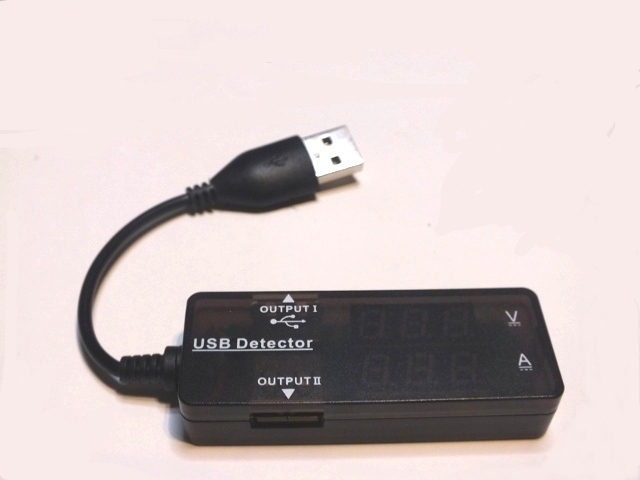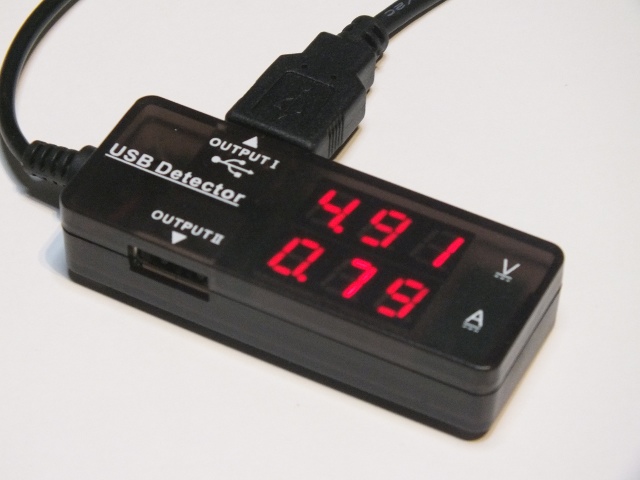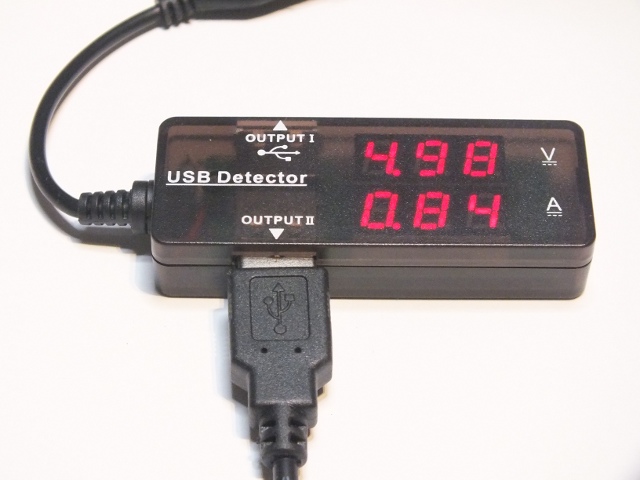Have you ever wondered how stable voltage your USB power source gives and how much current does your device take (your mobile phone charging or own circuit? 0.28″ LED 3-Digit Red Display USB Power Charger Data Transmit Current Voltage Tester (3~10V/0~3A) is a product that can do that. It shows the charging voltage and current for mobile phone, mobile power supply, tablet or any similar device. The detection range is e3~10V / 0~3A. This is very suitable for USB meter because USB voltage is 4.75-5.25V (5 V ± 5%) range and current normally in 0-500 mA range (up to 1.5A for charging). This product has two LED displays at pretty compact size (6.9 cm x 2.6 cm x 1.9 cm).
I have earlier tested another product USB-AV USB Power Current Voltage Tester – Translucent Blue + Silver. On thing on this earlier tested product that later annoyed me in lab testing was that the product all the time alternated between voltage and current display. For laboratory testing separate measurements displays for both voltage and current are a big plus so you can see the value you want to see all the time.
0.28″ LED 3-Digit Red Display USB Power Charger Data Transmit Current Voltage Tester (3~10V/0~3A) separate displays show both current and voltage all the time (display rate is 500mS). Promised accuracy 1% ± 2. I tested it against multimeter and another USB meter, and it feels that accuracy is good (could only verify that the measurements were accurate to at least few percent). Current display starts showing current when current taken from USB port is 20 mA or higher. The measured voltage value seems the voltage the meter receives on the input connector (output voltage from meter is slightly lower at high currents due voltage drop in current shunt). The device takes it’s operating power from USB port: Power consumption <20mA from USB.
There is another USB output that provides only charging:
The functionality is similar to USB condom: just pass the charging power and do not allow any data communications. This is a good security feature because there are potential dangers when you connect USB cable. You plug the smartphone into a socket and it starts charging – the same as with a flashlight or a toothbrush, right? But, in fact, there are some hidden dangers which you need to be aware of. Public charging stations help smartphone users, but also open a new avenue for hacking.There is some electronics in this product that makes charging work as well on both charging ports, but data moves around at only port OUTPUT I. If you are unsure of some public charging location USB power output security, plug in the meter to it to see that voltage is OK. When this is checked to be OK, then plug your smart phone to OUTPUT II so you get the charging power but the charging station can’t try to hack your phone through USB data pins.
0.28″ LED 3-Digit Red Display USB Power Charger Data Transmit Current Voltage Tester (3~10V/0~3A) is well working USB charging meter that has also USB charging (hacking) protection functionality built into it. This is good to measure how well USB charging works, test USB power supplies and how much current your own USB hardware takes. The price is reasonable ($9.91 at time of writing this).



7 Comments
regular says:
Greetings from Florida! I’m bored to death at work
so I decided to check out your blog on my iphone during lunch break.
I enjoy the knowledge you provide here and can’t wait to take a look when I get home.
I’m shocked at how fast your blog loaded on my mobile ..
I’m not even using WIFI, just 3G .. Anyhow, superb blog!
Tomi Engdahl says:
Here is link to one more expensive USB tester with more features:
USB Tester 2.0 Bundle
http://store.hackaday.com/products/usb-tester-2-0
It’s a small board with a USB Micro B connector at one end, a ‘normal’ USB A receptacle at the other end, and test points in between. It does one thing, and it does it well. If you’re down with experimenting with USB, the ID pin on the Micro B connector is also broken out. If you’re developing something with USB OTG, this will make things easier.
The logging and graphing capabilities of the backpack are incredible. With the app developed just for the USB Tester 2.0 backpack, you get live feedback of the current, voltage, wattage, and the voltage on the USB data lines. All the data can be saved to a file, allowing you to do fancy power analysis of USB peripherals.
Tomi Engdahl says:
Review: FriedCircuits USB Tester
http://hackaday.com/2015/06/19/review-friedcircuits-usb-tester/
Over the last decade or so, USB has somehow changed. It’s not just for connecting printers, keyboards, mice, and webcams any more. It’s not even just for stuff you would have plugged into a serial port. It’s a power outlet. If you want to charge your phone, plug it into a power outlet that can deliver up to 2.5 Watts.
Being a power outlet, having a device to measure current, voltage, power, and all the other intricacies of the what’s going on inside a USB cable would be neat. The USB Tester from Fried Circuits is that device.
The Fried Circuits USB tester isn’t so much a single device, but a small set of tools that allow you to probe everything going on inside a USB cable.
In its simplest form, it’s just a board with a USB A connector at one end, a USB micro connector at the other, and breakouts for measuring current, voltage, the differential data signals, and that weird ID pin that’s useful if you’re working with USB chargers or OTG devices.
Tomi Engdahl says:
Planning to make a DIY USB meter? Here are tips for this:
Simple USB Power Meter
http://hackaday.com/2015/09/07/simple-usb-power-meter/
The device measures voltage and current and displays them, along with the calculated power, on the small 0.5″ OLED display. The circuit is built around an ATmega328. To keep the board size small, and reduce component count, the microcontroller is run off its internal 8MHz clock. A low-resistance shunt provides current sensing which is amplified by the LT6106 a high side current sense amplifier before being fed to the 10 bit analog port of the ATmega. A MCP1525 precision voltage reference provides 2.5V to the Analog reference pin of the microcontroller, resulting in a 2.44mV resolution. Voltage measurement is via a resistive divider that has a range of up to 6V.
The OLED display has a SPI interface and requires the u8glib library. The project uses all SMD parts
http://www.electro-labs.com/diy-usb-line-power-meter-stick/
Tomi Engdahl says:
USB Charger Cable Review – The Good, the Bad…and the Ugly!
https://www.youtube.com/watch?v=doMHmGatyYc
In this video I use the USB Power Monitor (see link below) to test USB Charger cables and see what losses they can potentially have.
Tomi Engdahl says:
NTT- The Klein ET910 USB tester
https://www.youtube.com/watch?v=IeA2wg49RVE
For testing USB sockets, power supplies and connected loads!
Tomi Engdahl says:
https://hackaday.io/project/189078-i-made-my-own-usb-doctor